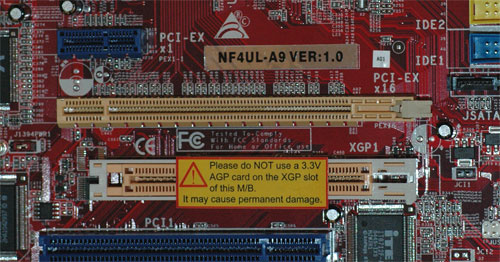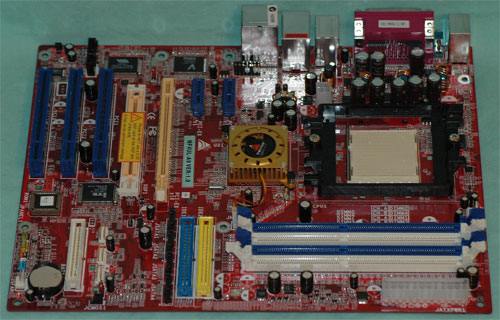nForce4 Ultra Roundup: Charting the Mainstream
by Wesley Fink on July 5, 2005 10:28 PM EST- Posted in
- Motherboards
Biostar NF4UL-A9: Features and Layout
| Specification | Biostar NF4UL-A9 |
| CPU Interface | Socket 939 Athlon 64 |
| Chipset | nForce4 Ultra (single chip) |
| BUS Speeds | 200MHz to 300MHz (in 1MHz increments) |
| PCI/AGP Speeds | Asynchronous (Fixed) |
| PCI Express | Fixed |
| Core Voltage | Startup, 1.2V to 1.625V in 0.025V increments |
| DRAM Voltage | Default, 2.7V, 2.8V, 2.9V |
| Chipset Voltage | NA |
| Hyper Transport Ratios | Auto, 1x, 2x, 3x, 4x, 5x |
| LDT Bus Transfer | 16/16, 16/8, 8/16, 8/8 |
| CPU Ratios | Startup, 4x to 25x in 1x increments |
| DRAM Speeds | Auto, 100, 133, 166, 200 |
| Memory Command Rate | Auto, 1T, 2T |
| Memory Slots | Four 184-pin DDR Dual-Channel Slots Unbuffered ECC or non-ECC Memory to 4GB Total |
| Expansion Slots | 1 x16 PCIe Slots 1 Xtreme Graphics Port (AGP 8X Form Factor) 2 x1 PCIe 3 PCI Slots |
| Onboard SATA | 4-Drive SATA 2 by nF4 |
| Onboard IDE | Two Standard NVIDIA ATA133/100/66 (4 drives) |
| SATA/IDE RAID | 4-Drive SATA 2 PLUS 4-Drive IDE (8 total) Can be combined in RAID 0, 1 |
| Onboard USB 2.0/IEEE-1394 | 10 USB 2.0 ports supported nF4 2 1394A FireWire ports by VIA VT6307 |
| Onboard LAN | Gigabit PCIe Ethernet by Vitesse VXC8201 PHY |
| Onboard Audio | Realtek ALC850 8-Channel codec with 6 UAJ audio jacks, CD-in, front audio, and optional coaxial SPDIF cable |
| Other Features | Dual-Core (x2) Support with BIOS nf4ua614 |
| BIOS | nf4ua614 |
Biostar took a different approach in the design of their nForce4 Ultra board. If you look closely at the video card slots, you will see how unique this board really is.

Even though it is not a full 8X AGP slot, the Biostar is still a unique and useful choice for those having AGP cards that they are not ready to replace. Those buyers can go to the Biostar with their current AGP card and still have the option of moving to PCIe on the same board at some time in the future. Since nForce4 does not support AGP, the Biostar allows AGP users to choose an nForce4 board anyway.
The Biostar is basically a sound board layout, particularly for a lower-priced nF4 motherboard. The 4-pin 12V power connector requires snaking the 4-pin power cable over or around the CPU, a design that many others also use. The board edge is a better location, and fortunately, the 24-pin ATX cable does reside on a board edge where it belongs. The 4 SATA connectors are a tight fit next to the PCIe slot, but they will work - even with a very long PCIe video card with dual power connectors.
The floppy connector is on the lower right edge of the board, which is certainly a better location than the bottom of the board, but still a longer reach than the preferred upper right location. Turning the IDE connectors sideways allows them to fit on the right edge near the center of the board. In most case designs, this will work fine, but a tall case with drives above the board chamber might require snaking IDE cables over DIMMs - not ideal for air flow.
BIOS controls on the Biostar were a pleasant surprise for an entry-level nForce4 Ultra motherboard. Just about every adjustment that you need for overclocking is here, including a useful vDIMM range to 2.9V, a wide CPU voltage adjustment range, and CPU ratio adjustments. The same goes for features, as our board even had dual Firewire ports controlled by a TI controller. Firewire is one of the first options to go when manufacturers build to a price point.
The only glaring omission is the lack of a standard SPDIF optical or coaxial out port. A board with 8-channel sound and 6 jacks should have a supplied SPDIF connector, not an optional feature.
We also ran into a very strange anomaly when benchmarking the XGP graphics slot. When we mounted an 8X AGP card and selected PCI as out boot video, the system booted just fine into Windows XP. However, the Gigabit LAN had mysteriously disappeared and no amount of searching for new devices would bring it back. We removed the AGP and reinstalled a PCIe video card and the Gigabit LAN was back. We hope that Biostar can find a way to correct this strange behavior in a future BIOS update.
Abit Fatal1ty AN8: Overclocking and Stress Testing
Biostar NF4UL-A9: Overclocking and Stress Testing











75 Comments
View All Comments
Andreos - Thursday, July 7, 2005 - link
Wesley - That helps, thanks for educating me on this stuff.Wesley Fink - Thursday, July 7, 2005 - link
#51 - We reviewed the K8NXP-SLI in the SLI roundup and the Ultra counterpart is the K8NXP-9. If you will look closely at the Gigabyte website pictures of the K8N Ultra-9 you will see it is the same board with a passive heatsink and fewer features. For information on how your Gigabyte performs at stock speeds (which is all that interests you) then please refer to the single video benchmarks for the K8NXP-SLI in the SLI roundup. We report all benchmarks at stock speeds so you and other readers can compare performance. Overclocking is covered as a separate feature. If you do not choose to overclock that is your business, but the information you are asking for is fully covered in our reviews. ALL the nForce4 Ultra boards perform almost the same at stock speeds, which should not really come as a surprise since the memory controller is on the CPU. If you were expecting the Gigabyte K8N Ultra-9 would perform better at stock speeds that anything else then you are badly misinformed. The Gigabyte boards do very well at stock speeds, but all the nF4 boards are close in performance at stock speeds.#53 - The BFG VNF4 Ultra is a rebadged (relabeled) Chaintech VNF4 motherboard. We did review the Chaintech VNF4 Ultra in this roundup.
VinnyS - Thursday, July 7, 2005 - link
I would have liked to have seen the BFG NF4 Ultra board included in this round-up, it got high marks in a [H]ardOCP review. Any chance for an update to this review with this board included?TheGlassman - Thursday, July 7, 2005 - link
Well I was tired, You were using the 6-3-05 bios, should have quit while I was ahead. So now I have no idea what the problem was.At any rate the 6-3-05 bios is a dual core bios, so no flashing to a beta is needed for dual core.
Andreos - Thursday, July 7, 2005 - link
I don't think you guys know your audience all that well. Not everybody is into overclocking to the hairy edge. Some of us wnat a fast and quiet board with dead-nuts solid reliability. For that reason, it is incomprehensible that the Gigabyte GA-K8N Ultra-9 was not included in this so-called "roundup". This board has no SLI counterpart, but it is of extreme interest to a lot of folks planning workstations based on X2 processors (and for which overclocking is of lower interest than reliable operation). Wake up dudes - the game is changing! Clock speed is no longer the Holy Grail. Other sites are savvy to this and will soon be eating your lunch!Palek - Thursday, July 7, 2005 - link
#49, no worries. I don't work for Anandtech, by the way. :)By my "far more than a day" remark I intended to say that I figured a review like this would take more like a week at a minimum - quite possibly even longer - to put together, so by the time the article was released some BIOSes would be outdated, since BIOS updates seem to pop up every other day these days. That is all.
TheGlassman - Wednesday, July 6, 2005 - link
Sorry Palek, you didn't write the review, oops. My apologies to you and time for bed.Wesley, can you look into that?
Thanks, and I'm sure glad the over a day remark wasn't yours.
TheGlassman - Wednesday, July 6, 2005 - link
Thanks for your comments Palek, especially the latest and greatest comment. I checked the bios you used for the chaintech, it is a dual core only beta, ANY release bios including the 6-03-05 official dual core support (a month older than either of the winning (because they over clock TCCD better?) boards, and older than any dated bios) will perform much better in overclocking and probably every other test.If Chaintech shipped you a board with that bios it wasn't a wise move for a single core test. I think it would be fair to retest the chaintech vnf4 with a release bios, and if the results are different to note that.
As far as the time taken to prepare this round up, much less time could have been used running bench mark after benchmark that shows apprx the same performance, and I would expect it take more than a day to write up such a comprehensive review. To take a few days to do testing that can benefit people who will base their buying decisons on your results, I think would be worth while.
I am happy that I could pinpoint the problem with the Chaintech VnF4 Ultra results, as you may have guessed I am quite familliar with it. In the past, Anandtech has always explained why a beta bios was being used, I guess that it wasn't noted this time because you felt rushed.
PS I know the DFI's are excellent boards, but their site lists a march date for their most recent bios, so maybe you should have used that one instead of their latest and greatest TCCD overclocking beta bios, and since you were using a beta, you should, again, have listed why.
I'm sorry, saying it took more than a day is not good enough for the anandtech standards that have been so high for so long.
Wesley Fink - Wednesday, July 6, 2005 - link
We have corrected the CPU and Memory voltage adjustments for the Abit AN8 Fatal1ty. This version only has voltage adjustments to 2.8V for memory, while the later Ultra and SLI versions do support memory voltages to 3.55V.Palek - Wednesday, July 6, 2005 - link
Wesley, that would be "proofreading" - one word! ;) Is that a job offer? :)#41, TheGlassman, you shouldn't have unreasonable expectations. I'm sure this review took far more than a day to put together, so of course some of the BIOSes used will not be the latest and the greatest. Adding three different types of RAM to the mix would require even more time. Then if you want to test them with different divider etc. settings, suddenly you have over a hundred combinations, a benchmarking nightmare. You have to draw the line somewhere. This was not an article focused on overclocking, but a comparison of 7 motherboards. I would have liked to see the new Abit boards included as well, but I guess that review will come soon enough, too.